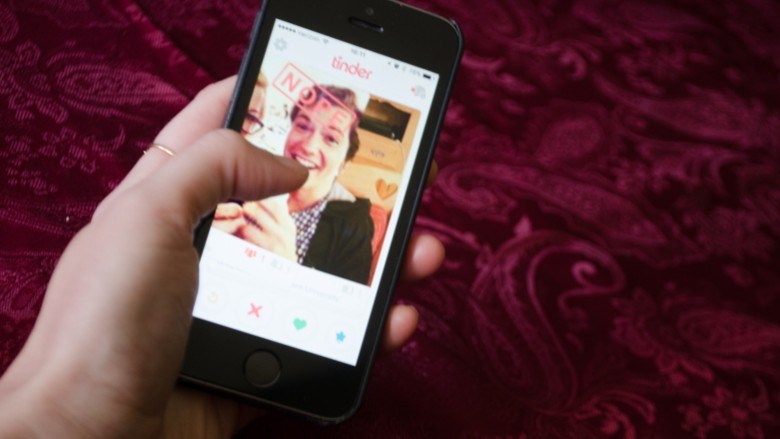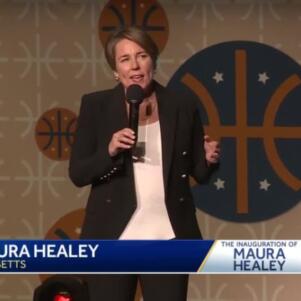Digital dating draws users but meeting face-to-face still rules
By Beth Treffeisen | February 11, 2016, 17:46 EST
 Swiping an image left or right has become a popular way to sort potential mates. (New Boston Post photo by Beth Treffeisen)
Swiping an image left or right has become a popular way to sort potential mates. (New Boston Post photo by Beth Treffeisen) BOSTON – More than a third of Boston’s population is between the ages of 20 and 34, making this college town home to the highest proportion of young adults of any major city in America. With such a young demographic, dating digitally may be becoming the norm for many living in the Hub.
Yet just 15 percent of American adults say they have used an online dating site and/or mobile app, up from 11 percent in early 2013, according a Pew Research Center survey conducted last June and July.
Meeting offline, face-to-face, remains the most common way couples who go on to marry first meet, according to a study by University of Chicago psychologist John Cacioppo. It showed that 65 percent of couples who married between 2005 and 2012 first met offline.
Still, the Chicago study cites the dramatic rise in online introductions. Much recent growth in online dating has occurred two particular groups that previously didn’t have much to do with it – the youngest adults and those in their late 50s and early 60s.
The Pew survey shows that online dating by those aged 18 to 24 has nearly tripled in the past two years, to 27 percent from 10 percent in early 2013. At the same time, among those 55 to 64, the rate has doubled to 12 percent from 6 percent.
For many college students, meeting a partner still most often involves people right in front of them in lunchrooms, classes, parties, or dorm rooms.
Richard Ryan, a freshman at Harvard University, said many couples meet up first in classes or through athletic groups.
“A lot of athletes hang out with other athlete groups, like football hangs out with volleyball,” Ryan said in an interview. “Then classes, dorm houses, if you live in the same floor or something,” he said, describing the way he typically meets people.
Samantha Kinde, a Boston University junior, doesn’t bother with online dating and steers clear of mobile dating services such as Tinder and Bumble, where users look at photos and swipe left, for no, or right for yes to create a pool of potential dates. While Bumble reserves first-message capability to females, Tinder lets either side break the ice.
“I just think they are ridiculous, which is not a common thought today,” Kinde said. “When I go to parties and somebody walks in and I go, ‘oh, they’re nice,’ I’ll go talk to them, but I wouldn’t say I’m actively going places to look for someone to date.”
While on some campuses mobile apps may be catching on as a way to initiate relationships, Harvard freshman Nicole Nishizawa has noticed that as students get older they start looking for longer-term relationships.
“I know a lot of upper classman and friends have boyfriends and stuff,” said Nishizawa. “People meet each other here at Harvard and fall in love.”
Outside of the college atmosphere, many young professionals search online for the perfect someone or for casual relationships. But that hasn’t always been the case.
For years there was a stigma attached to going online to find a date, as it was seen as an act of desperation. But that view is fading. In the Pew poll, just 16 percent of Internet users agreed with the statement: “People who use online dating sites are desperate,” down from 29 percent in 2005.
As more online and mobile dating sites pop up, the American public is making use of them in greater numbers.
Among online services, two stand out. Match.com, where users typically pay $42 a month, has about 23.6 million users, according to StatisticBrain.com. Users of eHarmony typically pay $60 a month, while the data site says it has about 16.5 million users. Both sites, along with others, try to attract new users with promises of long-term relationships. But it comes at a cost averaging $243 a year.
For many young professionals, the thought of shelling out money for promises that might not be met can be daunting. As smartphones have become increasingly ubiquitous over the past few years, numerous apps have appeared that let users browse through potential partners on the go, for free.
One of the most popular of these apps, Tinder, now has an estimated 50 million users, according to the CNBC cable network. In addition to user photos, the app also provides age and location. Once matched, the app provides a channel for a conversation.
Another popular smartphone dating app that has emerged is OkCupid, which began in online form and has gone mobile. A premium version costs about $10 a month and allows a subscriber to upload an extensive profile, then scan nearby users. A similar app, Hinge, introduces users to people they already have a connection to through Facebook.
Another app, Coffee Meets Bagel, strives to provide quality over quantity by matching users with one “bagel” a day that they can chose from.
Most of these apps let users to talk one-on-one through private “chat rooms,” letting them get to know each other before deciding whether to date.
With so many options out there, many people are getting the sense that there will always be someone else out there should a relationship end.
“I’ve had plans to have dinner with one guy and then somebody I like better will text me about drinks and I’ll do that instead,” Shannon Truax, a social-media director from Seattle, according to a story in a March 2014 Cosmopolitan article. “The way I see it, I’m researching and homing in on what’s important to me in a man. It makes sense that you would swap out somebody for somebody else. There is always somebody else.”
People who use dating apps have multiple dating partners about 53 percent of the time, like Truax, as a way to keep their options open.
Dating digitally has changed the game for many. By 2040, a projected 70 percent of couples will first meet virtually, so be prepared for a whole new world of relationships that start with your cell phone.











